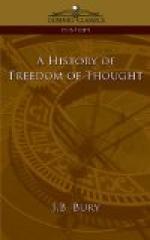[71] hand. At last it came into the possession of a man who had three sons whom he loved equally. Unable to make up his mind to which of them he should leave the ring, he promised it to each of them privately, and then in order to satisfy them all caused a goldsmith to make two other rings so closely resembling the true ring that he was unable to distinguish them himself. On his death-bed he gave each of them a ring, and each claimed to be his heir, but no one could prove his title because the rings were indistinguishable, and the suit at law lasts till this day. It is even so, my lord, with the three religions, given by God to the three peoples. They each think they have the true religion, but which of them really has it, is a question, like that of the rings, still undecided.” This sceptical story became famous in the eighteenth century, when the German poet, Lessing, built upon it his drama Nathan the Sage, which was intended to show the unreasonableness of intolerance.
CHAPTER IV
PROSPECT OF DELIVERANCE
(The renaissance and the reformation)
The intellectual and social movement which was to dispel the darkness of the
[72] Middle Ages and prepare the way for those who would ultimately deliver reason from her prison, began in Italy in the thirteenth century. The misty veil woven of credulity and infantile naivete which had hung over men’s souls and protected them from understanding either themselves or their relation to the world began to lift. The individual began to feel his separate individuality, to be conscious of his own value as a person apart from his race or country (as in the later ages of Greece and Rome); and the world around him began to emerge from the mists of mediaeval dreams. The change was due to the political and social conditions of the little Italian States, of which some were republics and others governed by tyrants.
To the human world, thus unveiling itself, the individual who sought to make it serve his purposes required a guide; and the guide was found in the ancient literature of Greece and Rome. Hence the whole transformation, which presently extended from Italy to Northern Europe, is known as the Renaissance, or rebirth of classical antiquity. But the awakened interest in classical literature while it coloured the character and stimulated the growth of the movement, supplying new ideals and suggesting new points of view, was only the form in which the change of spirit
[73] began to express itself in the fourteenth century. The change might conceivably have taken some other shape. Its true name is Humanism.




